Not being able to travel is a bummer for many people stuck at home this festive season. But you can take your virtual holiday this year end in Norway, England, Vinland in the North America continent and even Asgard in the largest and most expansive Assassin’s Creed game yet.
The latest title in the long running Assassin’s Creed franchise, Assassin’s Creed Valhalla (AC Valhalla), pushed the boundaries even further from what was already a very ambitious game in the previous AC Odyssey.
A pride and joy for AC fans in Singapore is that the Singapore studio played a huge part in AC Valhalla’s development. Their accomplishments include working on almost a quarter of the entire game, which is no small feat seeing how big the game is.
They also worked on spectacular water effects, which you have to see to believe, the longship features and activities, the well-varied biomes of the many regions in the game, and even the idea of recruiting a cat as a raider on the longship.
So how does AC Valhalla compare with its predecessors and is it worth your time and investment?
A Long Viking Saga
You play Eivor, a Viking warrior of the Raven Clan during the Dark Ages in Europe. After falling out with the new leader of the original clan in Norway and seeking to avenge a blood feud, Eivor struck out to set up a new settlement in England together with Sigurd, a sworn brother and a Jarl (Norse chief) to be.
Eivor works to establish alliances with the leaders of each region and attempts to influence politics in order to earn stability for the Raven Clan in England.
However, being a stranger in a strange land is never easy, and as rifts begin to form in the Raven Clan and egos get the better of some members, things begin to unravel.
As with any Assassin’s Creed game, the story has links back to the Assassins versus Templars (known as The Order), this time in the form of actual representatives in the form of the Hidden Ones that accompany Eivor in the missions and even set up a bureau at Eivor’s base.
The person on the Animus who is playing through the memories in the genetic code is Layla Hassan, the same modern day protagonist since AC Origins.
Increasingly, I am finding it a stretch for the recent AC games to accommodate the Animus and Assassins versus Templar storyline, even more so when stealth and sneaking have taken a backseat.
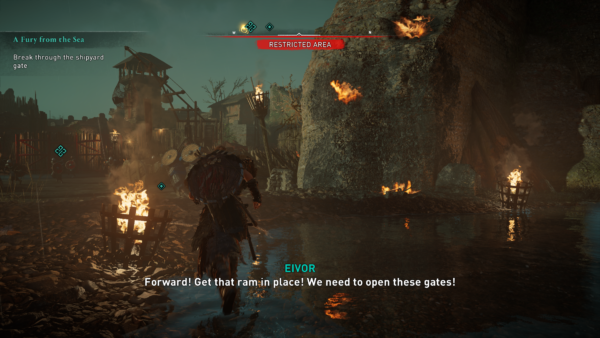
But that’s just my AC purist pet peeve. With that out of the way, I can’t deny that AC Valhalla is a lot of fun, and has many things going for it that will satisfy most gamers.
After spending over 100 hours in the game, including exploration, side quests, mini games and looking for treasure, I found it so compelling and suspenseful that it was hard to pause.
Although playing the role of an invader makes me feel rather uncomfortable initially, the game tries to balance that by making the existing rulers evil clouts that the people are happy to be rid of.
So, Eivor is more of a liberator of oppressors than an invader. There are also lots of quests for Eivor to help people out, which make gamers feel a little better.
The Assassin’s Creed Valhalla world is a massive one. Apart from the main politically driven plot taking place in England, there are also missions in Vinland as well as the fantastical and mythological realms of Asgard and Jotunheim, which Eivor can access under the influence.
In Asgard, you get to meet characters from Norse mythology including Loki, Thor and Freyja, and in Jotunheim, blue-skinned frost giants known as Jotuns. It’s a grand and ambitious way of weaving Norse mythology into the story and letting you play through it.
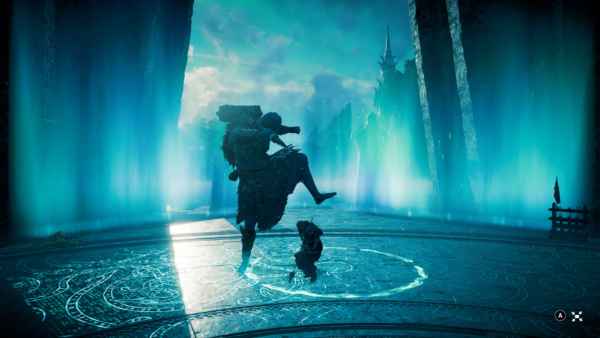
And if you get tired of playing Eivor as a man or a woman, you can swap anytime at the Inventory > Animus menu.
Unlike in AC Odyssey where Kassandra and Alexios are two distinct characters, AC Valhalla is completely neutral where Eivor’s tale plays out the same whichever gender is selected. Yes, even the many romances that you can choose to have Eivor partake in.
This is taking the open world genre to the next level, and it’s quite interesting how gender really doesn’t need to be a consideration in this story.
The gender pronouns do get mixed up sometimes, with people still addressing Eivor as “she” when I had switched him out to be a “he” mid-game.
I tried out both Eivors just to make a comparison, and I felt the male actor for Eivor was more natural and realistic – somehow, the lady Eivor sounds like she’s trying too hard to be gruff or has a bad throat.
The game also offers plenty of customisations in terms of hairstyles and tattoos to create the Eivor of your liking.
Crew Cuts
In terms of gameplay, I found AC Valhalla cleaner and less complex compared to AC Odyssey. Gone are the ship versus ship naval battles, which takes away the whole exercise of finding resources to upgrade the ship or finding crew members with the right stats to boost the ship.
All upgrades to the longship are now limited to cosmetic enhancements, so there’s no need to spend as much time on it.
AC Valhalla instead focuses on expanding the settlement and upgrading buildings and when enough supplies and raw materials have been accumulated through raids.
Raids on monasteries can feel rather cruel and self-serving, but are necessary to get materials to expand and grow your settlement.
As you play through missions and World Events, some Jomsvikings (mercenaries) can be recruited to join your crew. If you can spare the silver, you can also hire other players’ Jomsvikings since they definitely lend a hand during intense close quarter melee battles.
In AC Valhalla, sneaking has taken a back seat although the old favourite trick of blending in with a crowd of monks or hiding in plain sight has made a welcomed return.
There isn’t a real need to use it though, since you can simply mow through all adversaries with brute force.
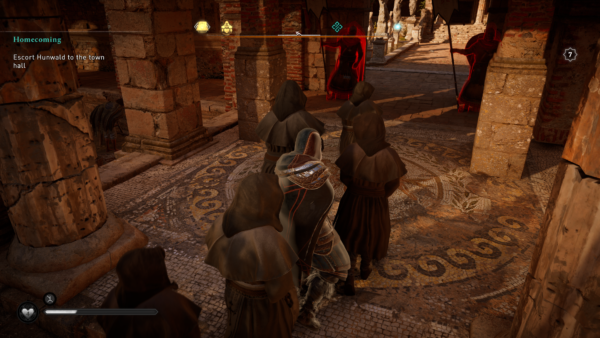
Apart from dealing melee attacks with axes, hammers and other weapons, Eivor is also able to use Special Abilities that are acquired through finding Books of Knowledge to add poison damage, throw axes and even use pets to dole out more hurt.
These abilities use Adrenaline, which are restored by killing enemies or eating certain foods, and are really cool to pull off especially when fighting tough bosses.
Endless Exploration
One of the biggest changes in AC Valhalla is the way it tries to make the player focus on completing the main story missions by region instead of haphazardly embarking on several quests at once.
The missions are organised into story arcs, which are self contained series of missions within the region.
It does help the player to focus better, since it has been more efficient in the previous AC games to collect all the side quests and then try to do them all at one go at the same region.
Although it allows for more freedom, that approach tends to manifest into checking off a To Do list than enjoying the stories or the NPC characters.
Regions are also limited by difficulty levels, so it makes sense to complete quests in certain regions to level up before moving to the next one.
Once the fast travel viewpoints of the region are unlocked, there will be treasure spots and events marked out on the map, which you can explore.
If you prefer to do the quests at other regions, you can by going back to the Ravensthorpe base and changing the pledged territory and story arc on the Alliance Map.
If you don’t, you can still go back to the region to continue the missions but the quests won’t be tracked on the map, so finding the NPCs to report out on mission completions can be rather inconvenient.
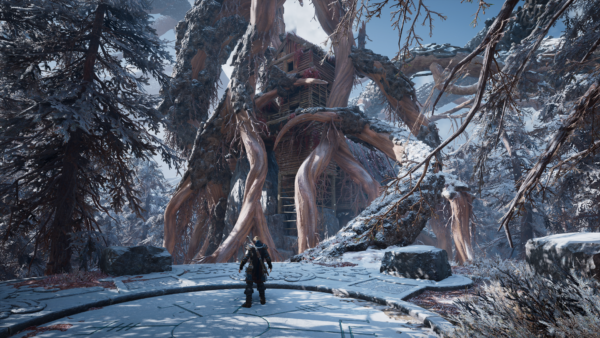
Instead of a multitude of side quests that one gathers and tries to check them off the list at a later time, AC Valhalla has a slightly different take with World Events.
These are localised side quests assigned by non-player characters (NPCs) which are meant to be completed in close vicinity to where you encountered them.
For instance, the quests would not ask you to travel someplace far to do something and come back to report on the mission being accomplished and getting a reward.
Other than World Events or Mysteries, there are other side quests that are not even tracked. Instead, you may need to look at the notes in your inventory to recall the details of what you might need to do, such as delivering goods for your local merchant or delivering items to the Hunter’s Hut or the Fishing Hut.
With no in-game tracking of which items are required, it makes for a rather annoying situation. In particular, the requirements of the Fishing Hut are very stringent and they only require certain sizes of fish.
I had happily gone back to the Fishing Hut report on what I thought was a successful catch only to realise that they needed the small versions of the bigger fish that I caught.
Without tracking the smaller quests, the game is prioritising these as “low urgency” quests, But for completist perfectionists, I find it annoying that there isn’t a holistic system to keep track of everything.
Additional work is needed by the gamer to find the note in the inventory or, if there isn’t a clue at all, make your own notes on what needs to be obtained.
The side quest tracking is something that needs to be improved on, maybe incorporating a list on the minimap or adding an additional dropdown might help.
That said, the World Events themselves are very well written and designed. Yes, there are plenty of fetch quests but the strong narrative and interesting characters that you meet disguises the fact and makes the quest feel a lot more meaningful.
Think of a father who misses his daughter, a retired Norse musician giving up hope in life, or a delusional man seeking his lost treasure. Side quests offer a good variety of puzzle solving, combat, or sleuthing and solving a mystery.
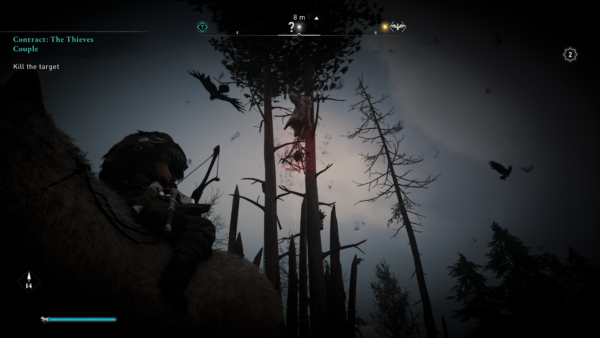
One of the more innovative Mysteries are evil places used for sacrificial rituals and dark magic that house a Cursed Symbol that needs to be destroyed.
Once Eivor is near one, floating dark spots will appear on the screen, the pounding of drums will get louder and more oppressive, and the controller will also vibrate intensely, filling you with a sense of dread.
The atmosphere is created really well and you can feel the lightness in the air once the Cursed Symbol is destroyed.
Other Mysteries include Standing Stones where you need to position Eivor at their focal point to unlock the whole symbol and complete the puzzle.
There are also Animus Anomalies in the form of a visual glitch and puzzles using beams of light that the modern day Layla Hassan on the Animus has to solve.
As Eivor travels around and meets more people, there are also mini games to entertain and challenge yourself with. Drinking games are fast paced quick time events and get more challenging the more Eivor drinks, just like in real life!
There is also Orlog, a traditional Norse dice game which tests your luck and strategy. Then there is my personal favourite mini-game known as flyting – a rhythm and rhyming game where Eivor and a challenger trade witty insults.
This is just a matter of choosing the best response with the best rhyme so it’s not as difficult as the drinking game. What’s useful about flyting is that it can increase Eivor’s charisma, which is useful in unlocking certain dialogue options where persuasion is important.
Besides the usual fast travel spots on the minimap that can be unlocked after climbing to the top and synchronising, Eivor can traverse bodies of water in longships and riding mounts such as horses, and even wolves and elks.
But travelling to Vinland and Asgard cannot be done via fast travel – for that, you need to make that choice in the story to ready a boat for long distance travel, or, in the case of Asgard and Jotunheim, drink a potion and enter a dream.
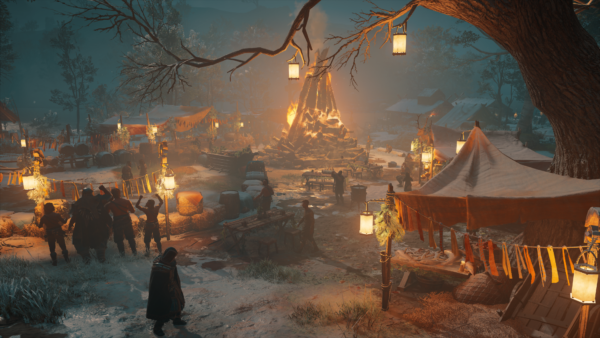
A new addition this festive season is the Yuletide festival at Eivor’s home base of Ravensthorpe. Here, you can take part in mini-games that involve a lot of drinking and collect tokens for some in-game loot!
Skills, Gear and Collectibles
Eivor levels up through gaining experience points (XP) through events completing mission objectives, killing enemies and finding treasures.
But unlike the normal way of levelling up simply by gaining XP, Eivor needs to invest in new skills using Skill Points that are earned once a certain number of XP is attained.
Eivor’s level correlates directly to the number of Skill Points invested in the Skill Tree, and this serves as a guide on matching the level of difficulty in the various regions on the map.
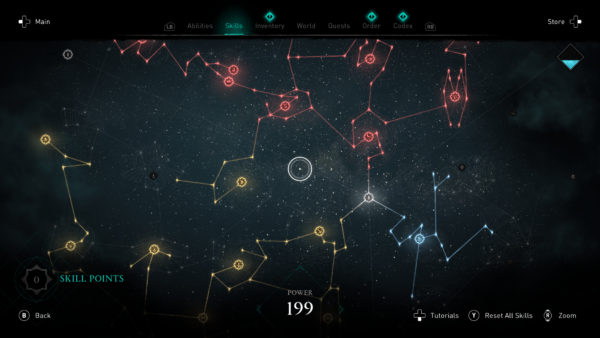
AC Valhalla’s Skill Tree is designed in the form of a celestial map. Once you unlock the last skill on the edge of a group, it opens up to another branch.
Plus, each branch has skills that focus on the three different families of gear, so there will be some “wastage” in getting certain skills you may not necessarily want simply to access a skill further down the path that you need.
The gear system in AC Valhalla is also different from its predecessors. For one, there aren’t that many resources to be gathered in the wild.
These are limited to smashing obsidian rocks to get ore, hunting animals for parts and leather, and picking berries for rations.
All other critical resources, weapons and armour are found by looting containers and not dropped by slain adversaries, which helps to reduce the hassle of inventory management.
Friends and Foes
Animals are featured extensively in AC Valhalla, where there are pet wolves, cats and dogs that Eivor can interact with, while others can be hunted for leather to be used in upgrading gear and other trophies such as hoofs, tusks, furs and so on, to be traded at the Hunter’s hut.
Eivor also has a pet raven, Synin, who can help scout locations and, if trained, can even distract enemies on command. A cute cat can also accompany Eivor on long journeys on the longship!
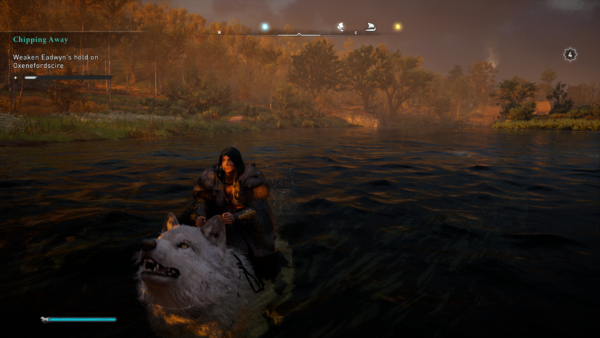
But not all are cute and cuddly. Predators like bears, boars and wolves will proactively attack, and even an angry deer can perform a hit and run on Eivor. There are also Legendary Beasts who are super tough that Eivor can beat for bragging rights.
Apart from hordes of Saxon soldiers and bandits, Eivor will encounter boss level enemies in the main story missions, including members of the Order who are to be assassinated.
There are also the dreaded Zealots reminiscent of Bounty Hunters in previous AC games who announce their presence with a horn and will aggressively attack Eivor if their paths happen to cross.
Sight and Sound
AC Valhalla is a great looking game with beautiful scenery, lively wildlife and realistic weather. However, compared to AC Odyssey where the exotic Greek islands and crystal azure waters make you feel like you are on a vacation.
The English countryside – although still pretty in its own way – pales in comparison for virtual tourism. In comparison, the smaller sections of the game featuring Norway, Asgard and Jotunheim offer a lot more visual excitement with the aurora borealis, snowy scenes and magical forests.
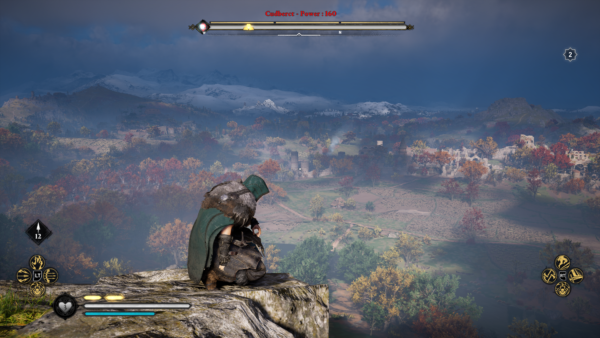
What is really amazing in AC Valhalla is the water, and you can visually tell that the water is in a pond, river and the ocean as they all look different.
And it’s not just the colour, it is also the viscosity, clarity and movements that make each body of water so distinct. This makes the new activity of fishing so much more enjoyable!
For the long hours of exploration, AC Valhalla’s beautiful soaring score is a great accompaniment, and is a treat to the ears. The crew also plays music and sings songs while sailing although they often get interrupted by a prospect of a nearby raid.
AC Valhalla includes subtitles for dialogue, which I highly recommend to turn on as there were some occasions where dialogues with key characters overlap with NPCs chattering or screaming.
But closed captions that highlight sounds in the game are another matter altogether. In spite of my intense FOMO (fear of missing out), I turned off the closed captions eventually as it got very annoying as it keeps notifying you about the “fire crackling” when all I really want to know is where the “wealth tinkling” is from.
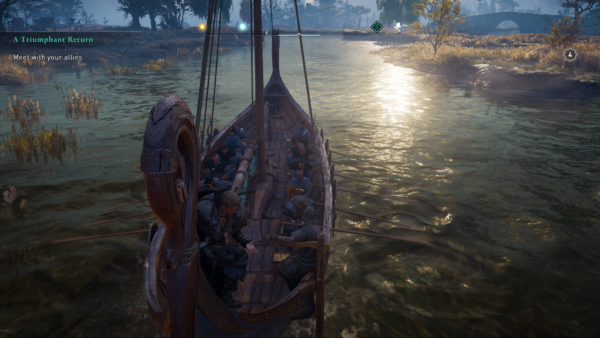
Bugs, complaints and cautions
All ambitious games of late seem to have their fair share of bugs or technical issues, and AC Valhalla is no exception.
The most serious incident for me is a broken quest where an NPC who needed rescuing didn’t show up, and all my attempts on researching and fixing this quest were fruitless.
It really bothers me to have an annoying Mystery that is unresolved showing up in the town of Lunden on my map.
Other issues include several occasions of the game crashing to the Xbox home screen as well as problems with the Ubisoft server that caused me to lose some progress in the game.
For the latter problem, I found that changing the configuration on the Xbox to “My Home Xbox” under General > Personalisation menu solved the problem.
I also became more disciplined about manually saving the game after a critical mission completion since I don’t trust the autosave function anymore.
And there are strange anomalies in the game, not just those for the Animus missions. The NPCs are pretty buggy, and I have encountered many who get stuck and march on the spot, float up in the air, jump in and out of water constantly, or never recover from panic and run around screaming non-stop.
I was so tempted to silence them with violence but killing NPCs will cause desynchronisation, so I had to try and listen to the dialogue among the din.
To allay some concerns about whether blood is visible in the game for the Asia region, I can speak for the Xbox and PC versions in Singapore that we can see all the blood, gore and violence.
Beheadings, dismemberments, fountains of blood spraying, and violent finishing moves can all be witnessed if you prefer, or turned off if you would rather not.
AC Valhalla’s gratuitous violence, coarse language, sexual themes, and occasionally bawdy humour mean that it is not a game for young gamers. For those with weak stomachs, be warned that there is also a graphic description of torture that can ruin the appetite.
TL;DR
All said, AC Valhalla is a super fun, crowd pleasing action game that scores in terms of gameplay, graphics and well designed open world exploration. Epic raids, storming of fortresses and large scale battles that satisfy action gamers.
However, with the downplay of stealth as well as the rather forced story elements of the Animus and Assassins versus Templar, AC purists will lament that the current games have strayed too far from their origins.
AC Valhalla’s ambitious story, characters and side quests are well written, with enough suspense, drama and macabre details to engage gamers.
And with first-rate graphics, cinematic cutscenes and great voice acting, AC Valhalla checks most of the right boxes.
If you enjoy Norse mythology, large scale battles, pillaging and raiding as well as a gripping storyline and a vast open world environment, you can’t go wrong with AC Valhalla.
That is, if you can overlook occasional bugs, annoying NPCs and possibly broken side quests that cannot be completed. Although I appreciate the effort by the developers in trying to focus the story within regions, the quest tracking mechanism leaves much to be desired.
AC Valhalla (Standard Edition) is available for Windows PC at S$79.90, Xbox at S$78.75 and PlayStation at S$84.90. The Gold and Ultimate Editions are also available at a higher price and include the bonus missions, Season Pass and other in-game goodies.






